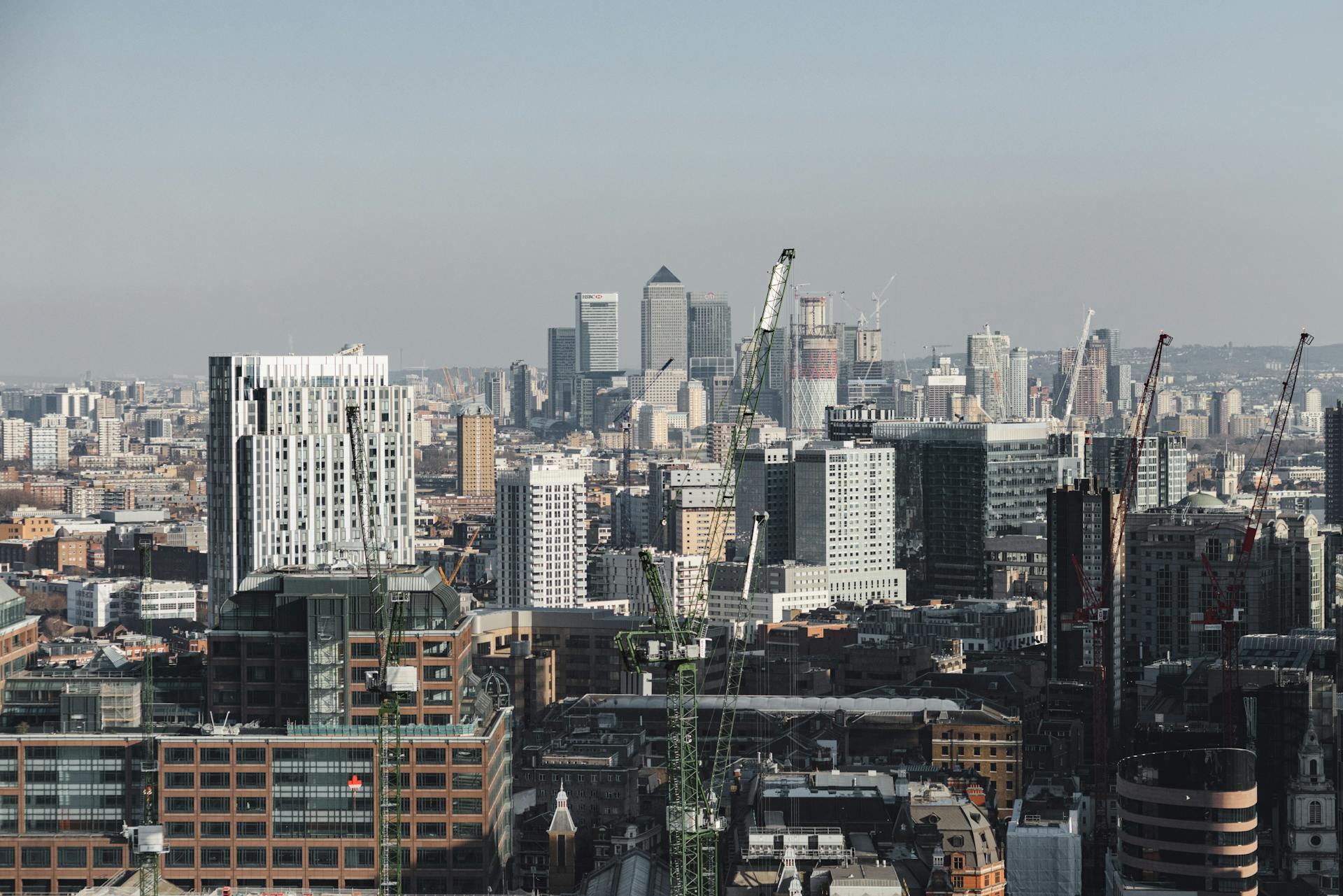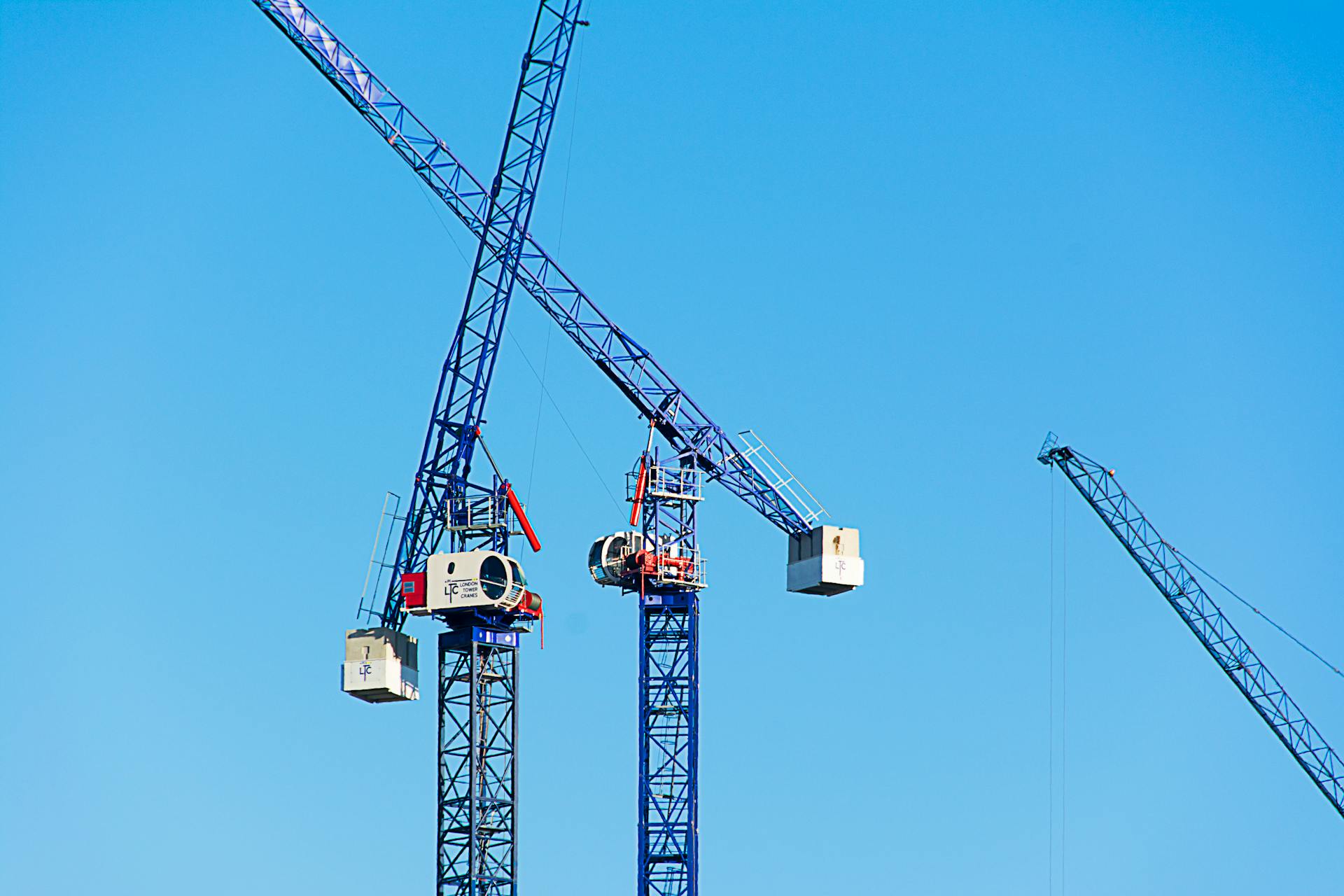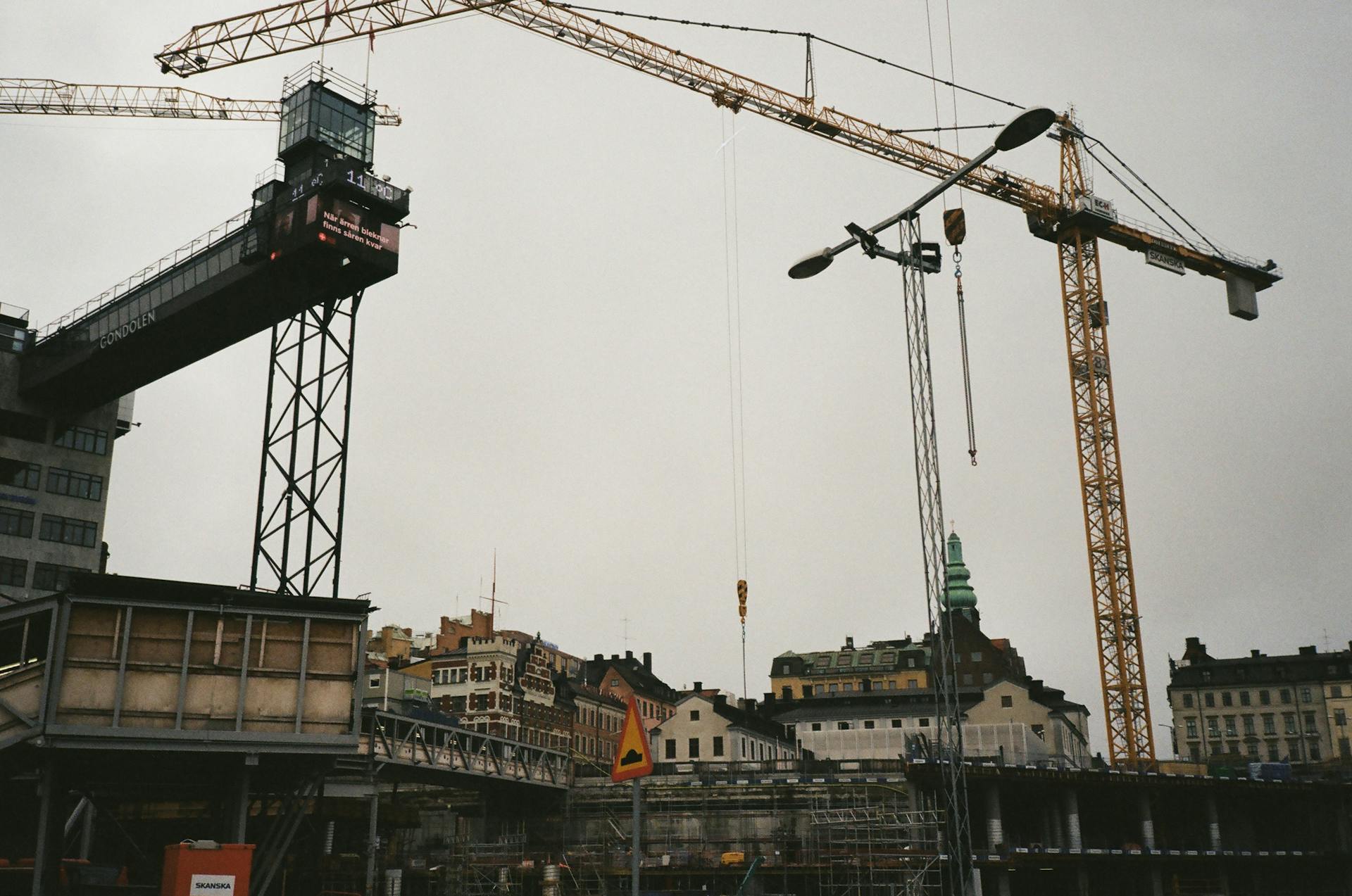
A cantilever jib crane is a versatile and space-saving option for lifting heavy loads. It's a type of crane that uses a horizontal beam, or jib, to move loads.
One key consideration when choosing a cantilever jib crane is the type of installation. There are two main options: wall-mounted and free-standing. Wall-mounted cranes are ideal for applications where space is limited.
The wall-mounted option requires a sturdy wall to support the crane's weight and the load being lifted. This type of installation is often used in manufacturing facilities and warehouses.
Free-standing cranes, on the other hand, are more suitable for applications where there is ample space and the crane needs to be moved frequently. They are often used in construction and logistics settings.
The size and capacity of the crane also play a crucial role in the installation process. A larger crane will require a more substantial foundation and support system.
Discover more: Wall Mounted Jib Crane
Crane Design and Types
Cantilever jib cranes are a type of crane that offers flexibility and versatility in various workspaces. They're often used in industrial settings where heavy-duty lifting is required.
A typical jib crane consists of several key components, including the reach/boom, mast/pillar, movable hoist, trolley, and rotation system. The trolley can be manual, motorized, or pneumatic, and it carries the hoist, wire rope or chain, and the hook along the entire length of the boom.
The mast type jib crane is a cost-effective alternative to freestanding systems, requiring only 6” of reinforced concrete to support the crane. This type of crane can accommodate spans of 10-40 feet, capacities up to 10 tons, and 360° rotation.
Mast type jib cranes come in two types of cantilever design options: full cantilever and drop cantilever. Full cantilever designs are used when there are no overhead obstructions, providing maximum lifting capability and clearance underneath.
Here are the key design features of modern day jib cranes:
- Unique Power Drive with Built-in Clutch
- Spherical Self-Aligning Roller Bearing
- Inspection Hole with Cover for Access to Collector Rings
- Machined Pressure Ring
- Torsion-Free Heavy Wall Column
- Special Gusset Flanges Designed for Strength
- Compact Baseplate
- Anchor Bolts and Template Package Available for Pre-Installation
- Removable Endplate
- Universal Adjustable Endstops
- Wire Rope or Chain Hoist
- Down Support with Torque-Free Design
- Machined Roller Box Ensures True Rotation
- Lockable On/Off Switch
- Power Feed
- Foundation Distributes Overturning Loads
Jib cranes come in several types, each designed for specific application needs and workspace configurations.
Installation and Mounting
A free standing jib crane requires a strong foundation, including footings, to support its independent structure. This allows for installation anywhere in a facility with sufficient space.
The free standing design offers a greater capacity range and longer boom span compared to wall/column mounted jibs. This makes it a versatile option for various applications.
For exterior installations, all jib crane solutions can be ruggedized for outdoor use, ensuring durability in harsh environments.
Freestanding
Freestanding jib cranes are a popular choice for many facilities because they can be installed almost anywhere, indoors or outdoors. They're incredibly versatile and can be used in a variety of settings.
A freestanding jib crane's independence from the building means it requires a strong foundation, typically in the form of footings, to ensure stability. This foundation is crucial for supporting the crane's load during a lift.
These cranes can accommodate spans of up to 50 feet and capacities of up to 15 tons, making them suitable for a wide range of applications. They also offer 360° of rotation, allowing for smooth and efficient movement.
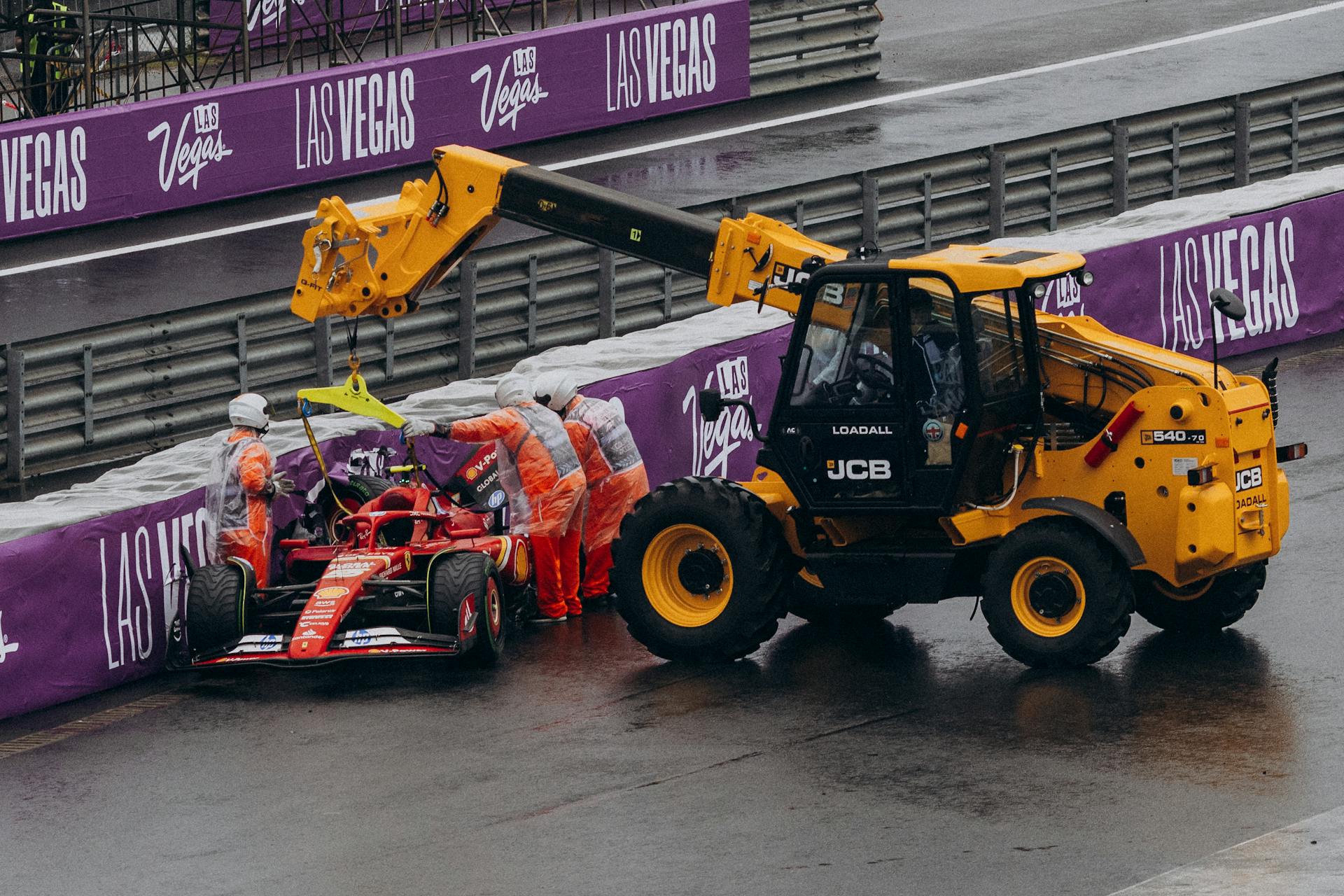
There are three main designs for freestanding jib cranes: Base-Plate Mounted, Foundation/Insert Mounted, and Sleeve-Insert Mounted. Each design has its own unique installation process and benefits.
Here are the key differences between these designs:
Freestanding jib cranes offer the highest capacities, longest spans, and greatest amount of rotation compared to other jib crane systems. However, they are also the most expensive and permanent setup due to the special foundation required to anchor and secure the crane.
Foundationless
Foundationless jib cranes are a great option for facilities that need a freestanding jib crane without the hassle of a special poured foundation. They can be slab-mounted and bolted to 6″ reinforced concrete for indoor use.
These jib cranes are incredibly fast to install, as you don't have to wait for a poured concrete foundation to cure. This speed of installation is a major advantage, especially in facilities where time is of the essence.
Typically, foundationless jib cranes can accommodate a range of sizes and capacities, including 9-16′ spans, capacities up to 1,000 lbs, 360° rotation, and boom heights up to 20′.
They're also super portable, as they can be easily relocated within a facility if needed. This flexibility makes them a great choice for facilities that need to reconfigure their layout or move equipment around.
Mounting Type
When choosing a jib crane, one of the most important decisions is the mounting type. There are two main options: wall-mounted and free-standing.
Wall-mounted jib cranes are a great space-saver, as they don't require any type of floor or foundation support. This makes them ideal for workstations where space is limited.
Wall-mounted jib cranes can be designed to swing around obstacles, under obstructions, or fold out of the way of overhead cranes. They can accommodate spans ranging from 8-30’ and capacities up to 5 tons.
The two main types of wall-mounted jib cranes are cantilever and tie-rod supported. Cantilever jib cranes offer the greatest amount of clearance, above and below the boom, while tie-rod supported jib cranes are the most economical means of providing hoist coverage.
Suggestion: Column Mounted Jib Crane
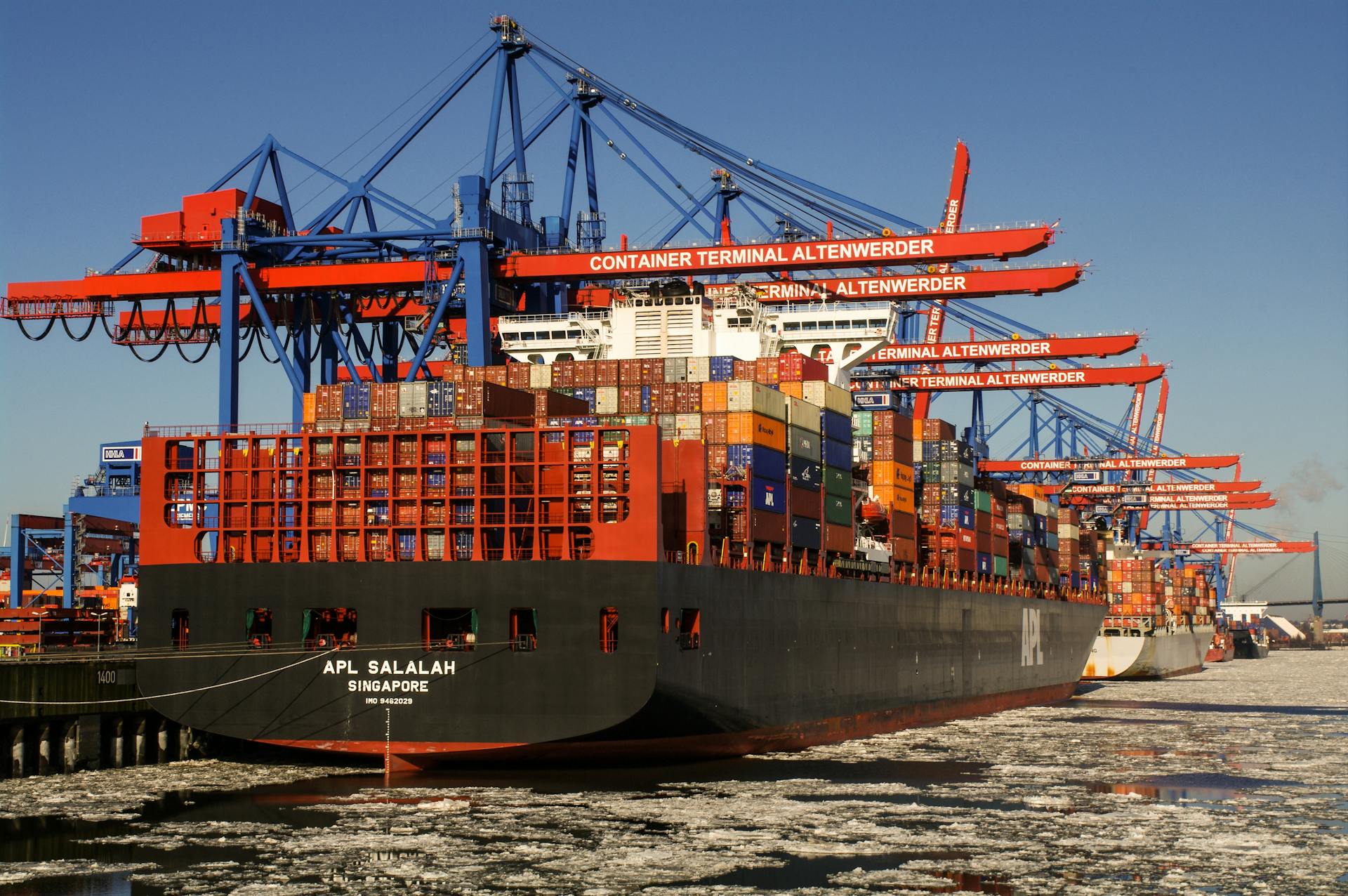
Here are the key differences between wall-mounted and free-standing jib cranes:
Free-standing jib cranes, on the other hand, require footings and a strong foundation, but offer greater capacity range and longer boom span. They can be installed anywhere in your facility with sufficient space.
Capacity and Features
Custom designed and installed high capacity overhead jib cranes are designed to meet exacting specifications, ensuring quality, reliability, and safety.
Munck Cranes offers a variety of solutions for all material handling needs, from large capacity overhead bridge cranes to high capacity jib cranes and extensions.
Jib cranes are an ideal solution for light or heavy duty material handling in a defined space, allowing operators to manage a wide variety of materials within a defined circular or semi-circular processing zone.
Wall or column mounted jib cranes are a cost-effective and reliable material handling solution that doesn't require additional columns or footings during installation.
The Munck Cranes team is eager to assist in selecting or customizing the ideal jib crane solution to align with your application and building requirements.
For more insights, see: High Rise Construction Cranes
Design and Installation
A cantilever jib crane's design and installation are crucial to its functionality and safety. The basic design and construction of jib systems make them simple to operate and require less maintenance.
Jib cranes typically have a few key components, including the reach/boom, mast/pillar, movable hoist, trolley, and rotation. The trolley's motion can be manual, motorized, or pneumatic, and it carries the hoist, wire rope or chain, and the hook along the entire length of the boom.
The rotation of the boom is a vital aspect of a jib crane's design, with freestanding and mast type jib cranes offering 360° of boom rotation, and wall and column-mounted jib cranes offering 180-200° of rotation.
You'll need to consider electrification/pneumatic power options, such as electric collector rings or pneumatic air lines, to provide rotation assistance and allow for continuous 360° boom rotation.
The controls of a motorized or air-powered jib system can be managed using a push button controller, which allows for control over the rotation of the boom, as well as the motion of the trolley and the lifting and lowering motion of the hoist.
A different take: Jib Crane Design Drawings
A rotation stop can be installed if the crane is located close to a wall or other obstruction, limiting the crane's motion before it collides with a nearby object.
In environments where corrosion, heat, dust, and dirt, or moisture may be a factor, special control enclosures can be designed for explosion-proof applications.
Here's a breakdown of the key components and considerations for a cantilever jib crane:
- Reach/Boom: the horizontal beam that the trolley travels back and forth on.
- Mast/Pillar: the vertical beam used to support the boom on freestanding and mast systems.
- Movable Hoist: the hoist is used to lift, position, and lower a load.
- Trolley: the motion of the trolley can be manual, motorized, or pneumatic, carrying the hoist, wire rope or chain, and the hook along the entire length of the boom.
- Rotation: freestanding and mast type jib cranes offer 360° of boom rotation, while wall and column-mounted jib cranes offer 180-200° of rotation.
- Electrification/Pneumatic Power: electric collector rings or pneumatic air lines can be added to provide rotation assistance and allow for continuous 360° boom rotation.
- Controls: push button controllers can be used to control the rotation of the boom, as well as the motion of the trolley and the lifting and lowering motion of the hoist.
- Hook Height: consider the lowest overhead obstruction to determine the height of your jib crane.
- Rotation Stop: a rotation stop can be installed to limit the crane's motion before it collides with a nearby object.
- Environmental Considerations: special control enclosures can be designed for explosion-proof applications and other environments where heat, dust, and dirt, or moisture may be a factor.
Components and Accessories
You can fabricate your own Wall Cantilever Jib Crane using the hinge components supplied by Spanco, along with all the hardware needed for bolting the hinges to the jib.
If you prefer a more turnkey solution, you can opt for a Wall Cantilever 300 Kit, which includes everything you need to get started.
Here are some additional components and accessories you can consider:
- Rotation Stops: These can be added to your crane for added safety and control.
- Hoist & Trolley Packages: These are available as an option for your crane, providing a convenient and efficient way to lift and move heavy loads.
Powered Rotation is also an option, available on new cranes or as a retrofit jib drive on 300-Series Jibs.
Portable
Portable components and accessories are designed to provide flexibility and convenience in various lifting tasks. They're perfect for temporary or mobile lifting needs, making them ideal for maintenance applications or workplaces where flexibility is required.
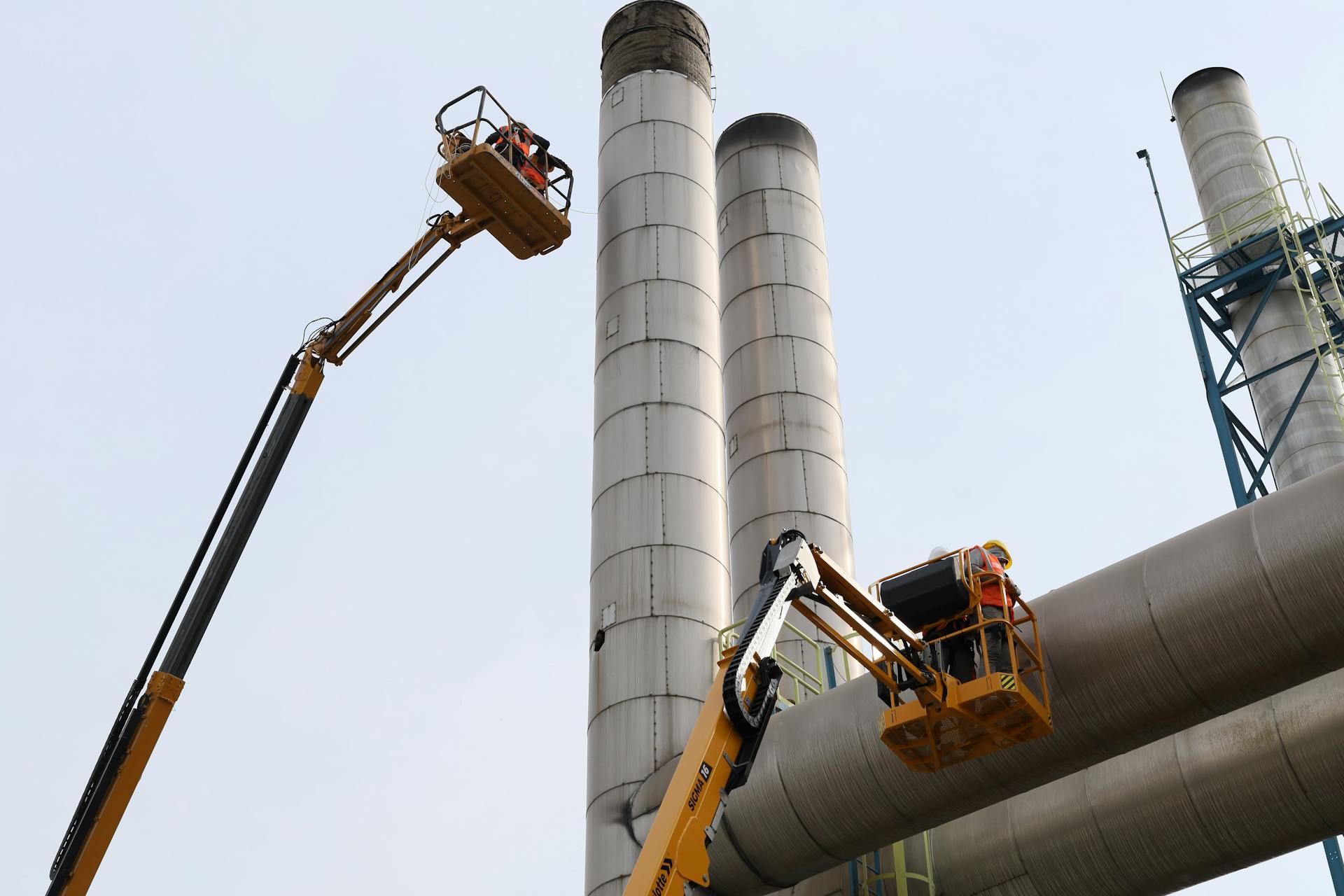
Portable jib cranes can be moved to different locations, offering a significant advantage in terms of adaptability. This is especially useful in workplaces with changing layouts or requirements.
If you need to lift heavy materials in a variety of settings, a portable jib crane might be just what you need. These cranes are designed to provide temporary lifting solutions, making them a great option for projects or tasks with short-term needs.
Some common types of portable components and accessories include crane and lifting products, crane services, crane upgrades, and crane guides. These items can be useful in a variety of situations, from maintenance to heavy lifting tasks.
See what others are reading: Heavy Equipment Operator Crane
Spanco 300 Series Wall-Mounted Features
The Spanco 300 Series Wall-Mounted Jib Cranes are a popular choice for many industries due to their space-saving design and versatility. They can be mounted to a wall or building support column, providing maximum clearance both under and above the boom.
Intriguing read: Wall Bracket Jib Crane
These cranes offer a full-cantilever design, which allows for the greatest amount of clearance. They can also be designed to swing around obstacles, under obstructions, or fold out of the way of overhead cranes.
The Spanco 300 Series Wall-Mounted Cantilever cranes have all swivel connections with bronze bushings and grease fittings, making rotation smooth and easy. This promotes long life and low maintenance.
Wall or column-mounted jib cranes can accommodate spans ranging from 8-30 feet and capacities up to 5 tons. They can also rotate 180°-200°, making them ideal for workstations where space is limited.
Here are some key features of the Spanco 300 Series Wall-Mounted Cantilever cranes:
- Full-cantilever design for maximum clearance
- 180°-200° rotation
- Spans ranging from 8-30 feet
- Capacities up to 5 tons
Material Standards
At Spanco, we're committed to using top-notch materials that meet the highest standards. All aluminum used in our cranes is made from 6061-T6 aluminum, which meets ASTM International specification ASTM B308.
This ensures our cranes are strong and durable. The aluminum used is a high-quality alloy that provides excellent strength-to-weight ratio.
Structural steel shapes used in our cranes meet the requirements of ASTM A-36, a widely accepted standard for structural steel. This ensures our cranes can withstand heavy loads and harsh environments.
Steel pipes used in our cranes are made from ASTM A-53 Grade B steel, which is known for its high strength and resistance to corrosion. This is especially important for cranes that will be exposed to the elements.
Square and rectangular steel tubing used in our cranes meets the standards of ASTM A-500 Grade B, which is a high-strength steel alloy. This provides added strength and stability to our cranes.
All steel used in our cranes has a minimum yield strength of 36 KSI, which is a critical measure of a steel's ability to withstand stress and pressure. This ensures our cranes can handle even the most demanding tasks.
Surface Preparation & Painting
Surface Preparation & Painting is a crucial step in ensuring the longevity and durability of your Spanco crane components. Spanco adheres to the standards of the Society for Protective Coatings (SSPC) for all product surface preparation.
Deburring and descaling are essential processes that remove any rough edges or debris from the components. Power tools equipped with sanding discs and wire wheels are used to achieve this.
A high-pressure/high-temperature biodegradable degreaser solution is used to wash the components, ensuring they are thoroughly clean before the painting process. This solution is effective in removing any dirt or grime that may have accumulated on the components.
The painting process involves coating the components with a quick-drying, semi-gloss enamel. This enamel is applied to a minimum dry-film thickness of 2 to 3 mils.
A finishing coat is applied using a hot, airless, electrostatic spray paint system, which provides a smooth and even finish. Painted components are then cured at air temperature, allowing the paint to fully dry and harden.
Options and Components
If you're looking to customize your jib crane, you have a few options to consider.
You can fabricate your own Wall Cantilever Jib Crane using the hinge components supplied by Spanco, which includes all the hardware needed for bolting the hinges to the jib.

These hinge components are part of the Wall Cantilever 300 Kits, making it a great DIY project for those with the necessary skills and tools.
A powered rotation feature is also available, either as a new installation on a crane or as a retrofit jib drive on 300-Series Jibs.
This feature can be a game-changer for heavy-duty applications, allowing for smooth and efficient rotation of the jib.
Options and Accessories
Rotation stops are a convenient option for jib cranes, allowing you to set a specific rotation point and preventing the crane from rotating further.
You can also choose to add a hoist and trolley package to your jib crane, which will give you more flexibility and control over lifting and moving heavy loads.
Sources
- https://www.mazzellacompanies.com/learning-center/jib-crane-design-types-components/
- https://www.munckcranes.com/products/jib-cranes/
- https://www.spanco.com/product/wall-mounted-jib-cranes/
- https://store.americancrane.com/viewitems/wall-cantilever-jib-cranes/gorbel-wc200-wall-cantilever-jib-cranes
- https://hsicrane.com/model-313-cantilever-style-jib-crane/
Featured Images: pexels.com
